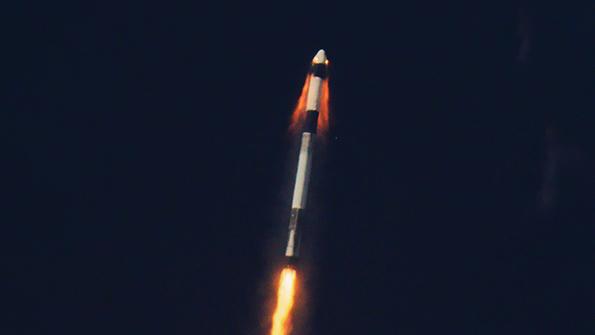
A fireball in the skies over Cape Canaveral is not typically a marker of a good day. But when a SpaceX Falcon 9 shut down 85 sec. after liftoff on Jan. 18 any tension in Firing Room 4 at NASA’s Kennedy Space Center was immediately eased by the sight of a small capsule soaring up and away from the ominous clouds triggered by the booster’s breakup over the Atlantic Ocean.
- Dragon flies off simulated failed booster
- Starliner timer anomaly under investigation
The rocket actually did not fail. Rather, its nine Merlin engines shut down as planned to simulate a launch abort, allowing it to tumble in the supersonic airstream, where it was ripped apart. Meanwhile, at the moment of engine cutoff the Crew Dragon capsule perched on the rocket’s nose fired up its eight Super Draco engines for an 8-sec. burn, accelerating the spacecraft from 1,200 mph (536 m/sec.) to 1,500 mph in approximately 7 sec.
No one was aboard Dragon for the Inflight Abort Test (IFA), the last major milestone before SpaceX launches veteran NASA astronauts Robert Behnken and Douglas Hurley for a trial run to the International Space Station (ISS).
But it would not have been a bad ride had crew flown Dragon’s escape system, which generated a combined 64,000 lb. of thrust, subjecting a pair of anthropomorphic test articles inside the capsule to 3.3 times the normal force of gravity.
Two min. and 25 sec. after launch, Dragon coasted to a peak altitude of 131,000 ft., jettisoned its unpressurized trunk section and fired up its smaller Draco thrusters to reorient itself so that its heat shield was positioned in the direction of travel for atmospheric reentry.

Two min. later, at an altitude of about 20,000 ft., Dragon jettisoned a panel near its nosecone, allowing mortars to fire to deploy a pair of drogue parachutes. Four 116-ft.-dia., orange-and-white main parachutes shot out 1 min. later and unfurled to slow Dragon’s descent to 20-25 ft./sec.
Dragon splashed down about 26 mi. east of Kennedy Space Center at 10:38 a.m. EST, ending an 8-min. 54-sec. flight test. “There’s a lot left to do . . . but by all accounts this was a very successful test,” NASA Administrator Jim Bridenstine told reporters after launch.
“It went as well as one can possibly expect,” added Elon Musk, the chief engineer, CEO and founder of SpaceX. “I’m super fired-up. This is great.”
In addition to a thorough analysis of the flight-test data, NASA wants two more parachute system tests before it will clear Behnken and Hurley to fly on another Crew Dragon to the ISS, a mission known as Demo 2. Launch could take place as early as April.
Demo 1, an unmanned Crew Dragon test flight to the ISS, was successfully completed in March 2019.
NASA also is working with Boeing on its CST-100 Starliner crew transportation system in an effort to restore U.S. human spaceflight services to the ISS, which ended in 2011 with the retirement of the space shuttles.
Both companies have faced technical challenges and lengthy delays. SpaceX, which had planned the IFA for last spring, lost the Crew Dragon capsule earmarked for flight on a test stand while pressurizing the propulsion system for a static test fire.
The Starliner’s orbital flight debut in December was marred by a mission-elapsed timer that was set 11 hr. ahead of the actual mission elapsed time, causing the spacecraft to run short of propellant for an engine burn to reach the station. An investigation is underway.
NASA needs both companies’ services and has downplayed any competition between the two to be the first to carry crew. For now, Russia operates the only crew ferry flights to the ISS. NASA’s last reservation for a seat on a Russian Soyuz capsule is for a flight set to launch in April.
The agency is mulling mission extensions to both Boeing and SpaceX upcoming crew flight tests to help fill the gap in ISS staffing. NASA also is negotiating with Russia for an additional seat should either of its Commercial Crew partners stumble in the home stretch.

Comments